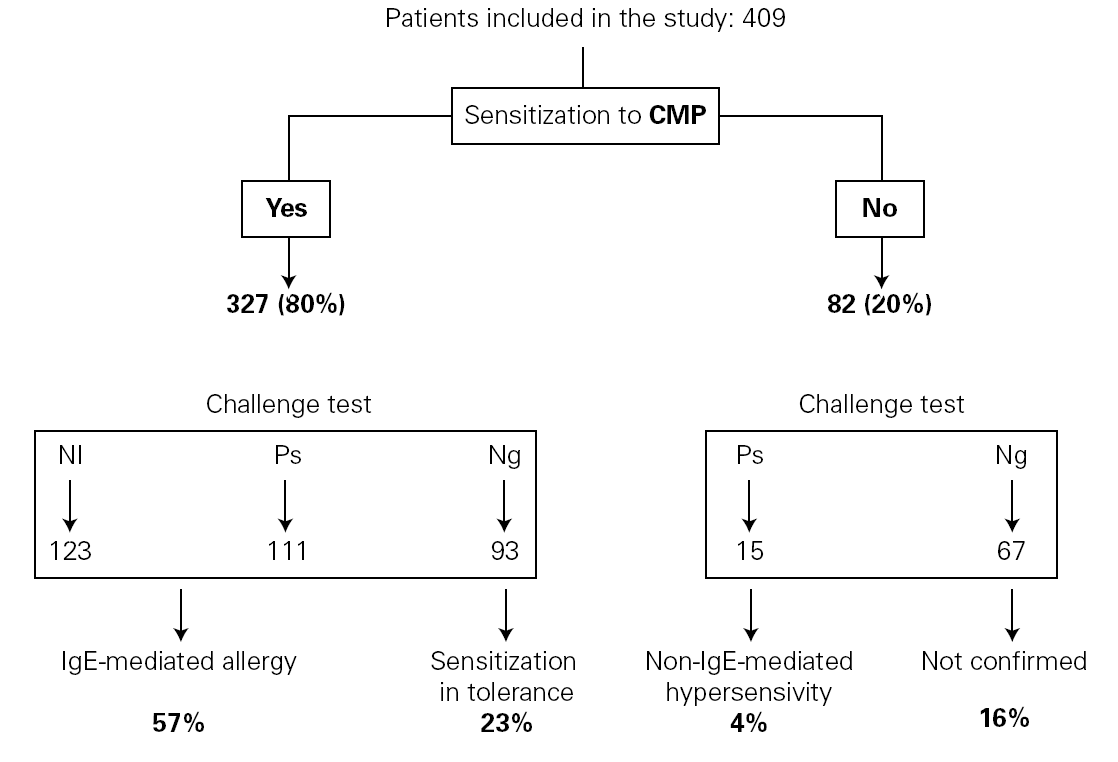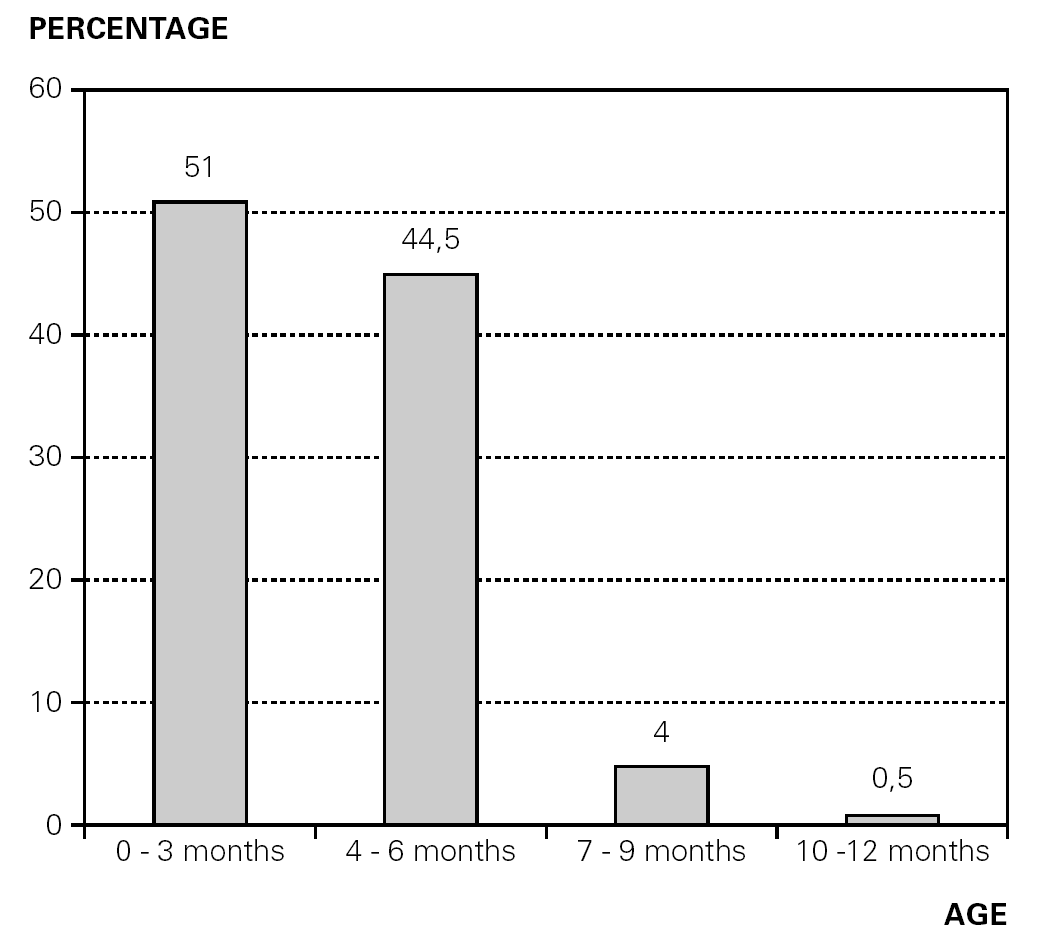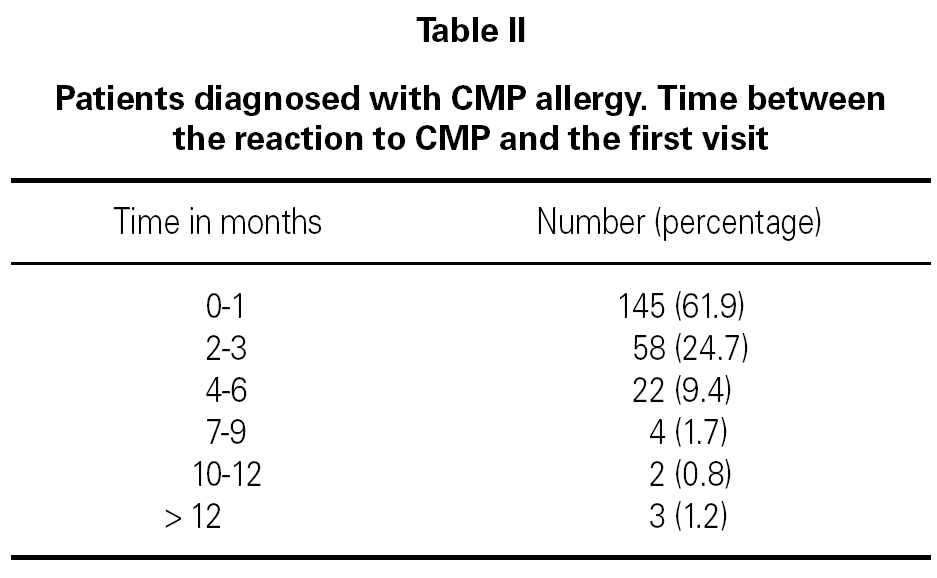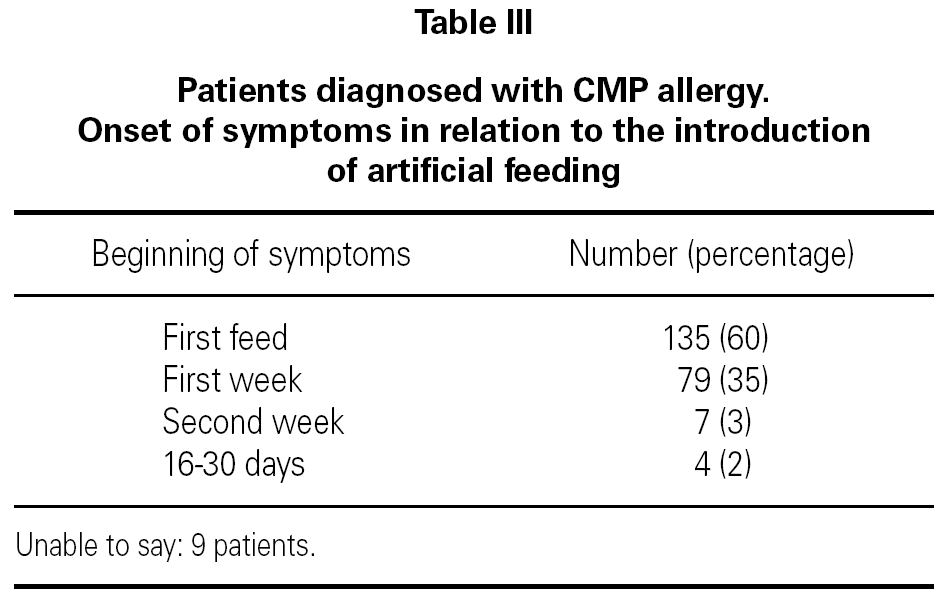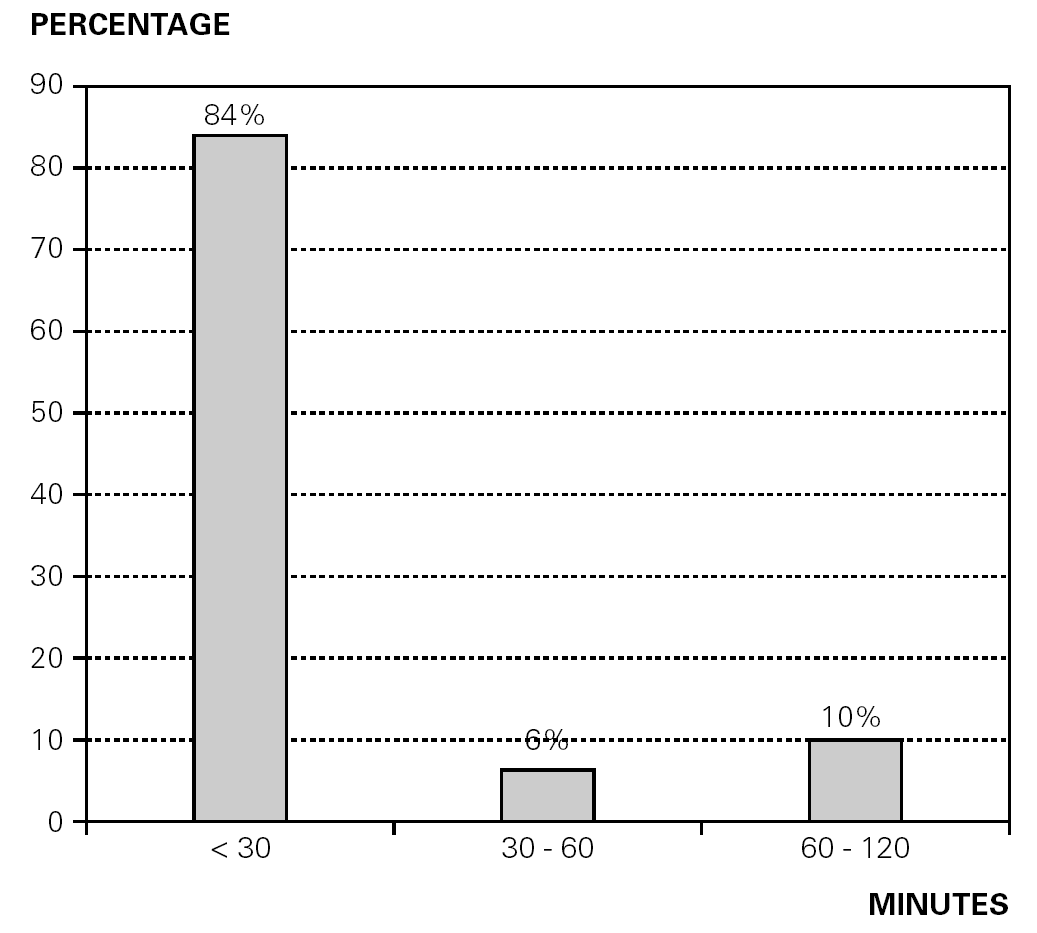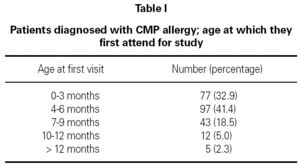INTRODUCTION
Hypersensitivity to a food comprises any measurable and reproducible adverse reaction due to the intake of that food in a dose tolerated by normal individuals. Distinction is made between allergic hypersensitivity, which is those reactions where an immunological mechanism is detected, and within these IgE-mediated and non-IgE-mediated allergy, depending on their mechanism. Non-allergic hypersensitivity reactions would be those in which the immunological mechanism is excluded 1.
Cow's milk proteins occupy the third place in frequency as a cause of food allergy during infancy, after eggs and fish 2. Although it is not the most frequent cause of food allergy, cow's milk attracts the paediatrician's attention as it is the first food foreign to its species with which the infant comes into contact, after breast feeding or from the first day of life when this is not possible. Development of sensitization and cow's milk protein allergy (CMPA) depend on the interaction between genetic predisposition and factors of exposure to cow's milk proteins (antigen dose, nature of the antigen, the mother's dietary exposure during pregnancy, transmission of cow's milk proteins (CMP) through the mother's milk, frequency of administration, etc) 3. The data provided by the international literature about its incidence are very varied, due to conceptual differences, diagnostic methodology, and ages studied, and they range between 0.3 and 7.5 % 4. In one of the most recent prospective studies published internationally and carried out in Denmark by Host et al, an incidence of allergy mediated by IgE to CMP of 1.2 % was observed in the first year of life 5. In a prospective study carried out in the Valencia Region, an incidence of 0.36 % was observed in the first year of life 6 and, in a subsequent study using similar methodology in the area covered by Hospital Sant Joan de Déu de Manresa, an incidence of 0.67 % was observed 7. Figures below those observed recently in babies born at Hospital Infantil La Paz over a period of one year, for whom an incidence of at least 1.9 % 8 is calculated.
So as to improve our knowledge about this important food allergy, the Food Allergy Committee of the Spanish Society of Clinical Immunology and Paediatric Allergology decided to start up a clinical and diagnostic and monitoring study of infants affected by CMPA. It is a multi-centre study in which the Paediatric Allergy Sections of 14 Hospitals took part.
In this study we refer to infants with CMPA. The cases of intolerance to other cow's milk products (e.g., lactose) or of allergic reactions to added products (e.g., penicillin) are not considered.
This prospective study set the following objectives:
1. Evaluate various epidemiological factors relating to the appearance of CMPA: history of atopy, age of onset, and type of feeding.
2. Observe how it is presented and what its clinical manifestations are.
3. Study the value of the skin tests and the determination of milk-specific serum IgE and its fractions in diagnosis, as well as the indication and the usefulness of the challenge test in the diagnosis of immediate hypersensitivity to CMP in the infant.
4. See whether there are other food sensitizations (beef, soy, egg and fish) and their clinical relevance.
5. Prospective study of the natural history of CMPA, to see at what age tolerance is established and its possible association with other allergic conditions (asthma, rhinitis etc.) during a monitoring period of 4 years with these children.
This is the first publication of this work and refers to the first two points of the aims mentioned.
METHODS
Subjects
A total of 409 children (213 boys and 196 girls) who had come to the Allergy Units of the Hospital General Universitario de Valencia, Sant Joan de Déu de Barcelona, Miguel Servet de Zaragoza, San Joan de Déu de Manresa, Universitario Infantil La Paz de Madrid, Severo Ochoa de Leganés, Niño Jesús de Madrid, General Universitario de Elche, Germans Trias i Pujol de Badalona, General de Igualada, Sant Joan de Déu de Martorell, Clínica Virgen de la Vega de Murcia, Clínica Universitaria de Pamplona, for the first time and who were selected consecutively over a 3-year period, because of symptoms suggesting immediate hypersensitivity to CMP (urticaria, angioedema, erythematous, rash, vomiting, diarrhoea, rhinoconjunctivitis, bronchospasms or anaphylactic shock) in the 2 hours after the intake of cow's milk.
Procedures
The full past medical history was recorded and a complete physical examination performed.
Skin test technique: Skin prick tests were performed in all patients with whole cow's milk extract (5 mg/ml), with isolated CMPs: α -lactalbumin (5 mg/mL), β -lactoglobulin (5 mg/mL), and casein (10 mg/mL) and with other foods: beef serum (5 % wt/vol), soy (10 mg/ml), hake (1 mg/ml), plaice (1 mg/ml), egg white (2 mg/ml) to study other possible associated food sensitizations. Histamine dihydrochloride (10 mg/ml) was used as a positive control, and glycerosaline was used as a negative control. Reactions were read at 15 minutes. A net wheal diameter 3 mm larger than that produced by the negative control was considered positive. Extracts from Laboratorios Leti CBF (Barcelona, Spain) were used.
In vitro test: Serum samples from all patients were analyzed for serum specific IgE antibodies to milk, α -lactalbumin, β -lactoglobulin and casein by using the CAP-system FEIA (Pharmacia Diagnostics, Uppsala, Sweden). The test was considered positive when a result of 0.35 kU/l was obtained.
Challenge test: Open controlled challenge tests with cow's milk were carried out with a formula of cow's milk adapted to the age of the patient. Two regimens freely chosen by the investigators were used: Regimen A first day: 2 ml, 5 ml,10 ml; second day: 25 ml, 50 ml; third day: 100 ml and the last dose to complete the quantity equivalent to one normal feed were given at 60-minute intervals. Regimen B in a single day, successive doses of 2 ml, 5ml, 10 ml, 25 ml, 50 ml, 100 ml. were given at 30-minute intervals.
If a clinical reaction appeared, the challenge was discontinued, and treatment was provided if necessary. The challenge was considered to be positive when there were skin (urticaria, angioedema, or erythematous rash), gastrointestinal (vomiting or diarrhoea), respiratory (rhinoconjunctivitis or bronchospasms), or generalized (anaphylactic shock) manifestations in the 2 hours after the intake of the food.
The challenge test was considered contraindicated in cases of anaphylactic shock and/or glottal oedema and non-indicated in patients who met all the following criteria:
1. Urticaria and/or Angioedema.
2. Appearance of symptoms in the first 60 minutes after intake.
3. Positive skin tests (≥ 3mm) and specific IgE ≥ 3 kU/l to any of the proteins.
4. Less than 3 months since the last clinical reaction.
If the infant was still being breast fed, the challenge test was postponed until the start of artificial lactation.
In those patients allergic to cow's milk sensitized to beef (Positive skin prick test, CAP system, or both) tolerance to this food was studied at the age when its introduction to the diet was indicated by means of an open controlled challenge test with boiled beef up to a total dose equivalent to a normal meal.
All of the challenges were performed at the Allergy Unit of the Hospital, where appropriate medication and resuscitation equipment was directly available. Informed consent was previously obtained from the parents. Each patient remained for 3 hours under observation after the last milk dose intake before going back home.
The patient was considered to show IgE-mediated CMP allergy when the following criteria were met:
1. A clear history of immediate hypersensitivity to CMP.
2. Positive skin prick test, CAP-system, or both, to whole cow's milk, α -lactalbumin, β -lactoglobulin or casein.
3. Positive cow's milk challenge test.
RESULTS
A total of 409 children (52 % male and 48 % female) of ages between 8 days and 22 months with an average of 5.5 months, were included in this study.
Allergic IgE-mediated sensitization (Positive skin prick test, CAP-system, or both) to cow's milk proteins was observed in 327 patients (80 %) and absence of sensitization in 82 patients (20 %). The Prick test was positive to cow's milk and/or one or more of its proteins in 289 patients (71 %). Serum IgE specific to milk and/or any one of its proteins was ≥ 0.35 kU/l in 280 patients (68 %).
A total of 286 challenge tests were carried out with cow's milk formula, proving positive in 126 (44 %) and negative in 160 (56 %). The challenge test was not considered indicated in 123 patients (30 % of the sample group). The challenge test was carried out as per regimen A in 134 patients (47 %) and regimen B in 152 patients (53 %).
Positive reaction symptoms to the challenge test were cutaneous (urticaria, angioedema, erythema) in 94 cases (75 %), digestive (vomiting, diarrhoea) in 43 (34 %), and respiratory in 10 (8 %), while 33 patients (26 %) were affected in more than one shock organ. Ten patients showed respiratory symptoms of rhinoconjunctivitis and/or cough and in only four of the cases could the reaction be considered serious due to its being associated with respiratory stridor. Two of these serious reactions occurred with regimen A (3 % of all positive challenge tests with regimen A) and the other two with regimen B (3 % of all positive challenge tests with regimen B). No cases of bronchospasm or anaphylactic shock arose.
With these results IgEmediated CMPA was diagnosed in 234 (57 %), CMP tolerant sensitization in 93 (23 %), non-IgE-mediated hypersensitivity to CMP in 15 (4 %), and in the remaining 67 (16 %) the adverse reaction in the challenge test or allergic sensitization was not confirmed (fig. 1).
Figure 1.--Result of the allergological study. NI: Challenge test not indicated; Ps: positive; Ng: negative.
Patients diagnosed with CMP allergy
Of the 409 patients included in the study, 234 (57 %) were diagnosed with CMP allergy. The first reaction to cow's milk occurred in all cases in the first year of life, 95 % before the age of 6 months, with an average age of 3.5 months and a range of between 10 days and 10 months of life (fig. 2).
Figure 2.--Patients diagnosed with CMP allergy. Percentage distribution in relation to the age when the first reaction to CMP took place.
The average age of the first consultation for allergological study was 5.4 months with a range of between 16 days and 20 months of age. 93 % attended before 9 months of age (table I). An average delay of 2.2 months was observed between the appearance of the reaction and the first consultation (table II).
Of the total of those allergic to CMP, 232 patients (99 %) had been breast fed before the reaction to cow's milk arose, during an average period of time of 3.5 months with a range of between 7 days and 10 months. Only two patients (1 %) were fed artificial cow's milk formula from birth.
In 44 % of patients, the mothers stated having offered supplementary cow's milk formula feeds during the period of breast feeding (35 % during their stay in maternity in the immediate neonatal period and 14 % during breast feeding). 56 % of mothers said they had not supplemented breast feeding in the neonatal period or subsequently.
Regarding the type of childbirth, 71 % were born by vaginal delivery and 29 % by caesarean section.
42 % of patients with CMP allergy reported atopic diseases (rhinitis, asthma, atopic dermatitis and/or food allergy) in members of their immediate family.
In most cases (60 %) the first symptoms of allergic reaction to CMP appeared with the first bottle of cow's milk formula following the period of breast feeding and, in 95 % of the cases during the first week following the introduction of adapted milk feeds (table III).
Clinical reaction appeared in the majority of cases within a latency period of 30 minutes after feeding (fig. 3).
Figure 3.--Patients diagnosed with CMP allergy. Percentage distribution compared with latency period of the appearance of symptoms after administration of CMP.
The most common clinical manifestations arising with cow's milk formula were cutaneous (erythema, urticaria, angioedema), which appeared in 94 % of patients, followed by digestive (vomiting, diarrhoea) in 33 %, and respiratory (coughing, bronchospasms, stridor) in 8 %. Respiratory symptoms were associated with clinical manifestations in other organs in all cases and only 4 % of the patients showed isolated digestive clinical signs. 25 % showed rejection to adapted formula bottle feeds.
In nearly a third of cases (32 %), clinical signs of anaphylaxis were seen affecting more than one organ, and only 12 patients (5 %) showed serious reactions with bronchospasms and or respiratory stridor. No patient had a record of anaphylactic shock.
21 % of patients manifested associated atopic dermatitis, which had begun before the appearance of clinical reaction to cow's milk.
Regarding sensitization to different cow's milk proteins, 93 % were sensitized to more than one protein (26 % to two and 67 % to more than two). 89 % of patients were sensitized to beta-lactoglobulin, 79 % to casein and 79 % to alpha-lactalbumin.
Sensitization to other food: Sensitization to egg was seen in 30 % of patients with allergy to CMP before this food was introduced to the diet. 42 % of patients sensitized to egg presented atopic dermatitis compared with 15 % of those not sensitized to egg.
Sensitization to beef was observed in 29 % of the patients studied. All subjects tolerated boiled beef.
4 % of patients with CMP allergy showed sensitization to soy. They all tolerated soy formulae. 3 % were sensitized to fish (hake and plaice) yet to be introduced to the diet.
DISCUSSION
To diagnose accurately IgE-mediated allergy, it is necessary for a compatible clinical history to exist, for cow's milk specific IgE type anti-bodies to be demonstrated by means of skin tests and/or the determination of specific IgE-mediated serum and its confirmation by the challenge test. The challenge test is contraindicated in the diagnosis of patients with severe anaphylactic reactions and is not necessary in all cases. In our study, 3KU/l was chosen as the cut-off point in the milk-specific IgE values to recommend the diagnostic challenge test or not, based on a previous study of infants allergic to CMP, in which this level showed a PPV of 91 % for a prevalence of 44 % 9.
This study highlights the need to carry out the challenge test, when indicated, in order to diagnose a CMP allergy, since in 39 % of the infants included in the study with a well-founded suspicion of adverse reaction to cow's milk, the existence of a clinical reaction following its intake was discounted and they therefore did not need it to be excluded from their diet.
Cutaneous signs (urticaria, angioedema, and erythema) are the most frequent and typical clinical expression of IgE-mediated CMP allergy and were present in 94 % of patients allergic to CMP in our study, being similar to the 99 % obtained by Garcia-Ara et al 10.
Another important clinical sign is the rejection by the infant of the adapted cow's milk formula feeding bottle, which was shown in 25 % of those allergic to CMP, which is an important clinical sign to be borne in mind.
The results of a recently published study by Eggesbo et al indicated that in pre-disposed infants, whose mothers were allergic, caesarean delivery could increase the risk of developing food allergies, which, according to the authors, could be related to the delay in intestinal colonisation of the new-born child 11. A higher percentage of deliveries by caesarean in our study than in the general population 12, was not observed to make us think of the influence of this factor in the appearance of CMP sensitization.
According to the results of our study, which confirm those obtained by other authors 13,14, CMP allergy begins to show clinically during the first year of life and appears after a more or less extended period of breast feeding, in many cases following the first feed with CMP adapted formula and generally in the first week of its being introduced in the diet. Sensitization may have occurred during pregnancy or after birth, during the period of breast feeding.
During pregnancy, small amounts of food proteins may cross the placenta and reach the foetal circulation to give rise to IgE sensitization in a genetically pre-disposed foetus. However, the tests carried out have failed to show protection against the development of CMP allergy with a diet excluding cow's milk during pregnancy. In the review of the Cochrane Collaboration carried out in 1999, no evidence was shown of reduction in CMP skin test prevalence in the children of mothers who followed an exclusion diet during pregnancy 15.
The main advantage of breast feeding in the prevention of food sensitization is based fundamentally on the relative lack of food allergens in human milk. However, this is a double-edged weapon, as experimental studies in animals indicate that small quantities of antigen, at microgram to picogram level, can preferentially induce IgE responses 16, whereas larger quantities, at the milligram level, suppress the IgE response and the degree of suppression depends on the dose 17.
Experimental studies have shown that oral tolerance to food proteins can be induced 18. The age of the animal and the food allergen dose are critical for tolerance to be induced. The neonatal period appears the optimum time 19. The larger the dose of antigen and its frequency of administration, the more probable it is for tolerance to be achieved and the IgE response suppressed 20.
It has been shown that small amounts of cow's milk proteins and other foods such as egg and peanut, can reach the infant via breast feeding 21-23. The quantity of beta-lactoglobulin contained in a drop of cow's milk has been calculated to correspond to the quantity of beta-lactoglobulin in 200 litres of mother's milk. But even so, mother's milk contains approximately as much beta-lactoglobulin per drop as the amount of pollen allergen inhaled per day during the hay fever season. Therefore, it is by no means impossible for children to become sensitized to cow's milk, even though they are breast fed exclusively 24.
In a recent prospective study carried out by Saarinen et al, which monitored 6209 infants from birth to evaluate the appearance of symptoms of CMP allergies, exclusively breast feeding for two months was shown to be a risk factor of allergic IgE-mediated response to CMP 25. Høst and other authors maintain that this only occurs if there has been prior exposure to this food during the neonatal period 26. However, studies by Saarinen et al show that, although feeding with adapted cow's milk formulae in maternity increases the risk of allergy to CMP when compared with other food supplements, exclusively breast feeding does not eliminate the risk and the accumulated incidence of CMP allergy was similar in infants who received a supplement of adapted formula in maternity as in those exclusively breast fed. In a controlled double-blind study carried out recently De Jong et al, feeding with cow's milk in the first two days of life before beginning breast feeding did not increase the risk of developing atopic diseases in the first two years of life 27.
In our study, only 41 % of those allergic to CMP had received supplementary feeding in maternity or during the period of breast feeding, for which, in contrast to the work of Høst, exposure during the neonatal period, although it may collaborate, does not seem decisive in the appearance of CMP allergy.
Clinical experience indicates that, in those infants receiving artificial adapted cow's milk formula from birth, the appearance of CMP allergy is exceptional 3,14. In our study, only two of the 234 infants diagnosed with CMP allergy had received artificial milk from birth. In these two cases, the administration of the adapted formula had been interrupted at one month of age due to digestive symptoms, with its being substituted by an extensive hydrolysate, with an allergic reaction to CMP ocurring when adapted cow's milk formula was reintroduced. Recently published experimental studies show that in non-sensitized mice, feeding with an adapted cow's milk formula for only one week or with a partial hydrolysate for 4 weeks develops oral tolerance to IgE response to CMP 28. However, those fed with extensive hydrolysate or casein serum did not develop tolerance, confirming earlier studies 17. Small peptides and amino-acids contained in extensive hydrolysates neither seem to be tolerogens or immunogens.
Introducing large quantities of CMP from birth and its subsequent uninterrupted administration seem to stimulate the induction and maintenance of tolerance and to prevent the appearance of allergic reactions to this food.
Interrupting exposure to the food allergen in sensitized and tolerant patients may result in loss of tolerance, as has been shown with some foods such as fish and peanuts 29,30.
Only 4 % were sensitized to soy with all of these being tolerant. Soy allergy is very uncommon in children with atopic illnesses and, in a group of 243 children with atopic parents, fed for the first 6 months of life with soy formula and monitored for 5 years, only one showed documented allergy to soy by means of skin tests and double-blind challenge tests 31.
Egg had not been introduced to the diet of the infants in our study, although sensitization to egg white was shown in 30 % of them. This data confirms the importance of studying sensitization to egg in those allergic to CMP in order to prevent the appearance of a reaction when it is introduced to the diet 32.
Sensitization to beef was observed in 29 % of the patients studied, although they all tolerated boiled beef. This is due to the allergen responsible for sensitization to beef being a bovine serum albumin that is thermolabile, which means that its allergic potential is destroyed by cooking 33 and it only produces a reaction when eaten raw or partially raw 34. This means that beef does not need to be excluded from the diet of children allergic to CMP as long as it is eaten cooked.
The CMPA fundamentally occurs during the first half year of life, coinciding with its introduction into the infant's diet, following a more or less extended period of breast feeding. Sensitization to CMP may appear after exclusively breast feeding, although the child has received no supplementary feeds of adapted cow's milk formula during breast feeding. In those patients with CMPA, sensitization to egg may be seen before its introduction to the diet. Carrying out an appropriate diagnostic protocol in infants attending for a suspected risk of cow's milk allergies enables allergy to be discounted in a high percentage of cases.
Correspondence:
Antonio Martorell, MD
Hospital General Universitario
Avda. Tres cruces, s/n
46014 Valencia. Spain
E-mail: martorell_ant@gva.es




